Creating and Editing Rows and Swimlanes for Version 6.0 (Portal)
Contents
About Creating and Editing Rows and Swimlanes
Rows and swimlanes are a feature of OnePager that help you to group, collect, and sort project tasks and milestones dynamically based on your underlying project data.
This article covers how to represent rows and swimlanes in your project views and the manual edits that are available with rows and swimlanes. Most row and swimlane editing is done globally, so you should also read the Project View Properties articles to familiarize yourself with some of the more common row and swimlane features.
Creating a Project View with Rows and Swimlanes
1) OnePager Pro and Express are distributed with a number of Templates that can be used to create various project view looks. Many of these Templates already have swimlanes defined. See the article at: Managing Templates (Portal) for more information.
2) Our recommendation for first users of OnePager is to create your first project view with the format specified by the current Template. Once the project view is created, you have the capability to make edits including designating which source plan field should be used to control the creation of rows and swimlanes.
3) For the purpose of this article, we will assume that you have created a project view without any visible rows or swimlanes and that you desire to organize your project view into swimlanes and provide at least one text column per row in the project view to display source plan information. Please review the Getting Started article at: Getting Started (Portal) to see the creation of a project view with a swimlane.
Displaying Rows and Swimlanes
4) Assuming that your project view is created and displayed in the Project-View Editor (PVE), you can now make the global edits necessary to display rows and swimlanes. This is done by clicking the Project-View Properties (PVP) button on the OnePager tool bar. This action brings up the PVP form where you should click the Rows/Swimlanes tab as shown below:
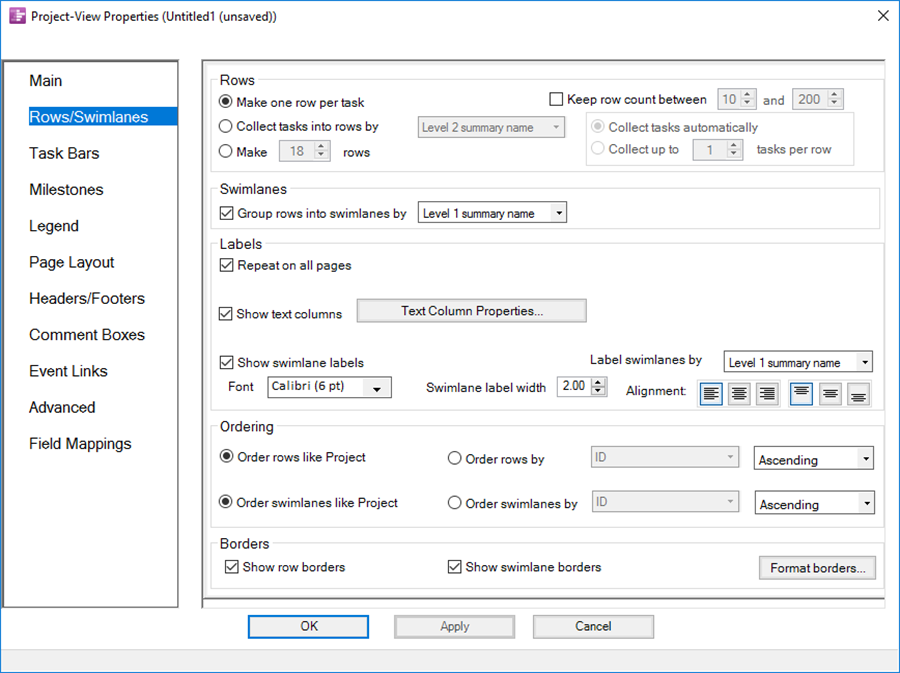
5) As shown above, the PVP Rows/Swimlanes tab is already configured to display the Level 1 summary name from the Microsoft Project source plan used in this illustration. For swimlanes these control setting will create multiple swimlanes and display text data taken from the source plan. To display additional text columns of data for each row(from 1 to 5 are supported), you need to d a little extra configuring as follows:
- a) Swimlanes are a collection of rows. To associate source plan data with each row go to the Show text columns checkbox and check it on. Next, click the Text Column Properties... button which will immediately bring up the Custom Text Columns form as shown here:
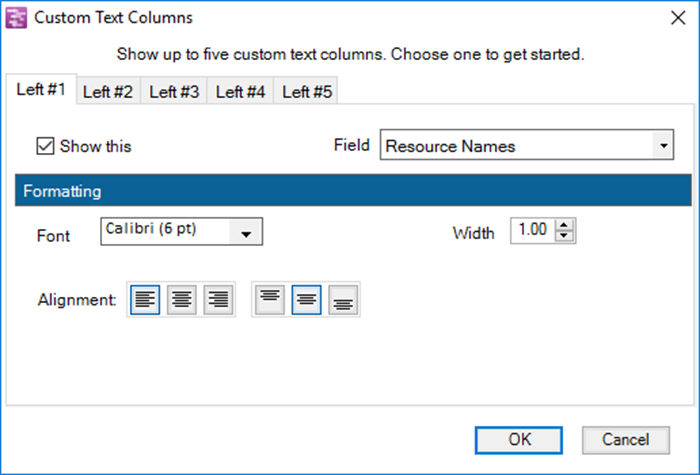
- b) Above is the basic form. To specify one or more additional text columns for your project view, start with the Left#1 tab in the form and click the Show this checkbox. The Field window dropdown in the illustration above is already set to Resource Names. When you click the OK and return to the PVP Rows/Swimlanes tab, the Reosource Names data field from your source plan will be used to provide associated text data in a column to the right of the Swimlane as shown below:
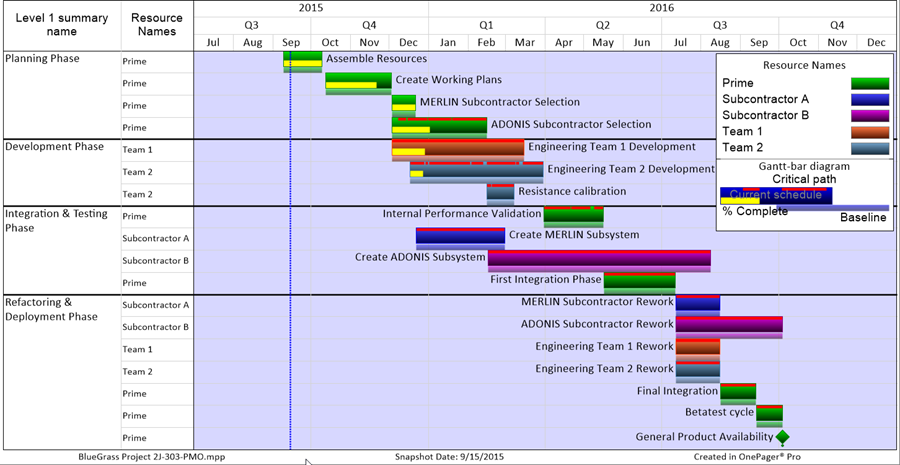
- c) You can now go back to the Custom Text Columns form and adjust the text in the Text Column by using the Formatting group in the form. You can also use the Left#2 to define an additional text column to support each row displayed in the project view.
Adding Swimlanes and a Text Column
6) To add one more additional text column to complete this example, suppose you want to also display for each row the %Complete value for each task in each row of the project view. This can easily be done as follows:
- a) Return to the PVP form's Rows/Swimlanes tab, make sure that the Show text columns checkbox is checked on, and then click the Text Column Properties button again. This action takes you to the Custom Text Columns form where, for this illustration, you should click the Left#2 tab.
- b) Next, click the Show this check box and use the Field window's dropdown list to select %Complete as shown here:
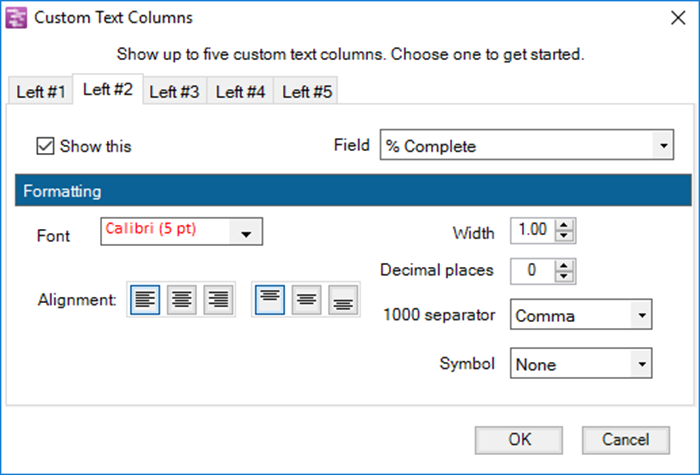
- c) When you click the OK button on the form above and work your way out of the PVP form, your project view will be reconfigured to look like this:
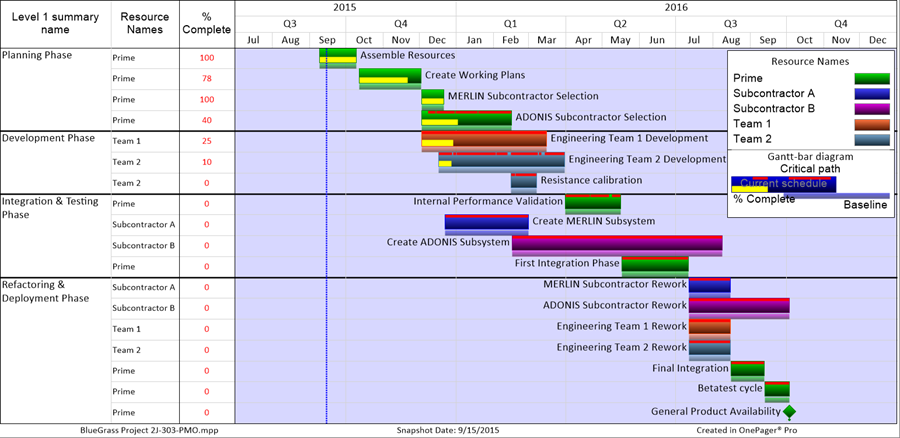
7) The process of adding additional text columns can be repeated so that up to five (5) additional text columns can appear on the left side of the graph.
Displaying Large Numbers in Additional Text Columns
8) Often when displaying cost data it is necessary to format the amounts with separators and currency symbols. As shown in the Custom Text Columns form above, when the Microsoft Project source plan field is numeric you have the controls necessary to insert commas or periods between groups of three digits in the numeric value as well as suppress the display of separators. Additionally, you have a control to select the currency type such as Dollars, Pounds, or Euros, for example.
- a) Suppose we have the following Microsoft Project source plan with the Cost field as shown below:
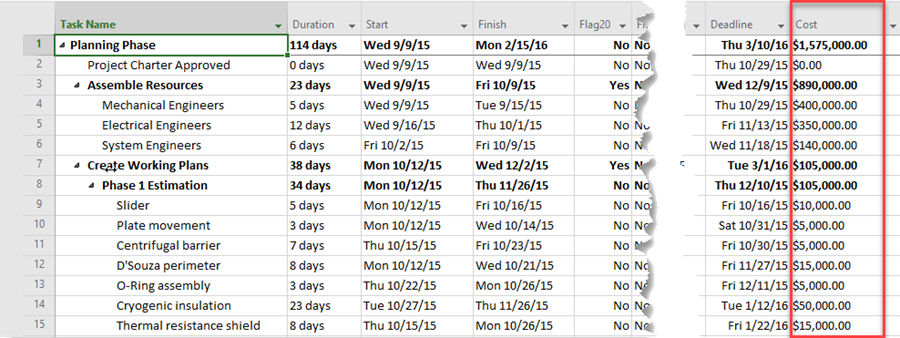
- b) What we'd like to do is display the Cost data so that it shows in an Additional Text Column in the project view the way it looks in the Microsoft Project source plan.
- c) One way to do this is to first create the basic project view which is shown below:
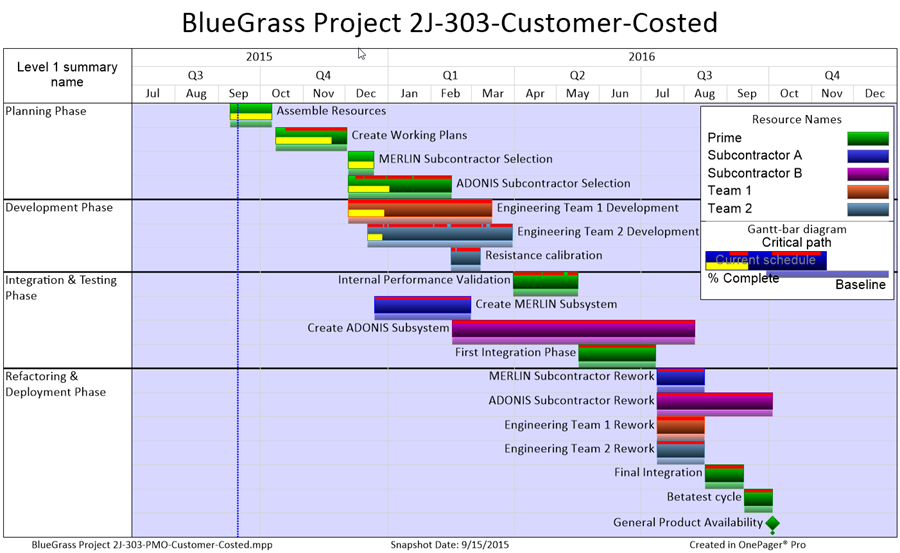
- d) Now, click on the Project-View Properties button on the tool bar, go to the Rows and Swimlanes tab, check the Show text columns checkbox, and click the Text Column Properties... button to bring up the Custom Text Columns form. Then, click the Left #1 tab and make sure that the Show this checkbox is checked. Finally, use the dropdown menu to the right to select the Cost field. These steps are shown in the illustration below:
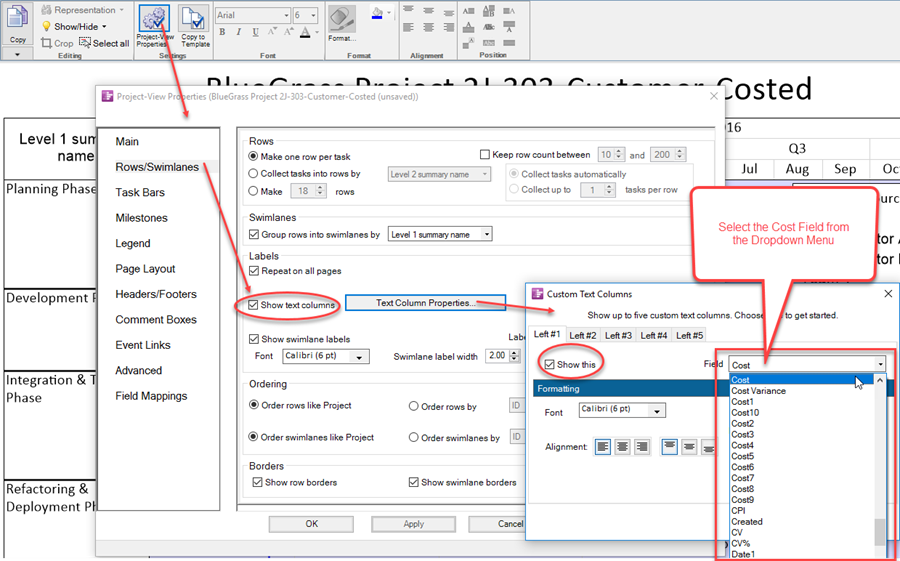
- e) After completing these steps the "'Custom Text Columns form will recognize that the selected Microsoft Project source plan field is numeric and the form will change to look like this:
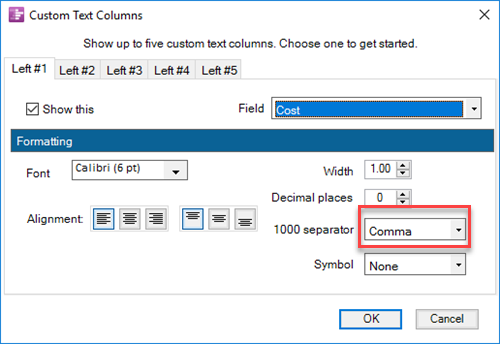
- f) The Comma is the default separator but the dropdown menu for the 1000 separator has three options as shown here:
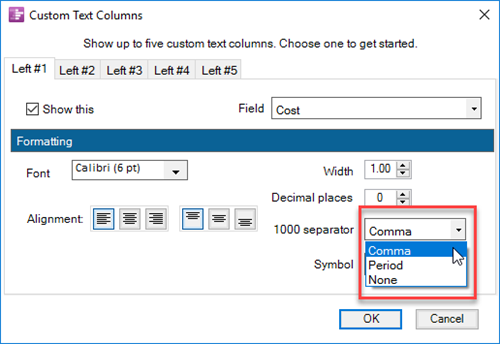
- g) Since the values in the Cost field are in US Dollars, use the Symbol dropdown menu to select the Dollar symbol as shown below:
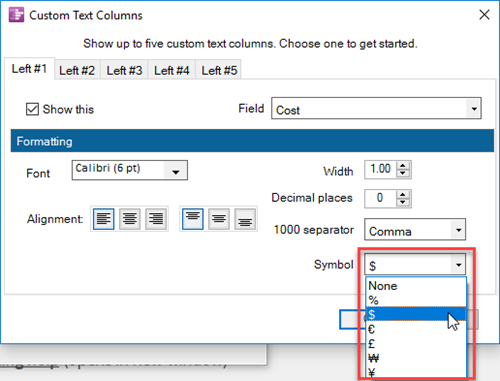
- h) After completing these steps, click OK on the Custom Text Columns form to close it; then click OK on the Project-View Properties form to close it. The project view will be updated to look like this:
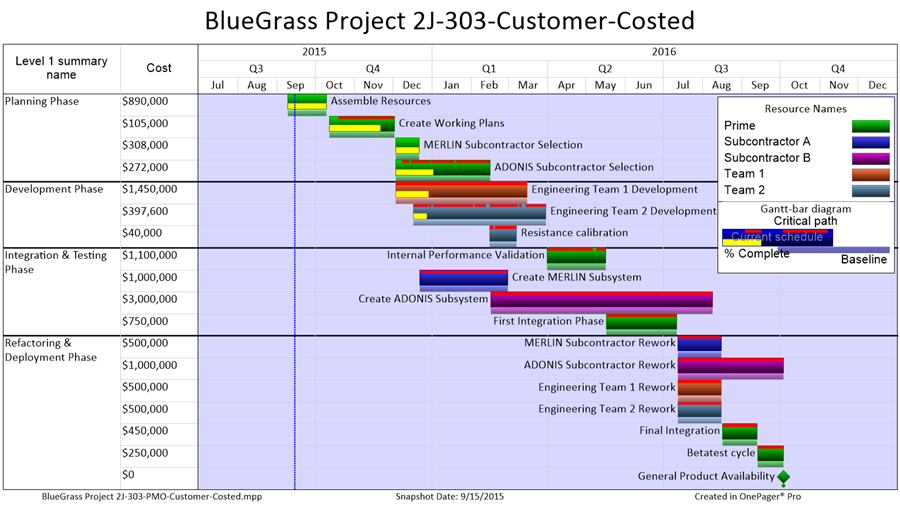
9) Once created, each Additional Text Column cell may be individually edited or the entire set of cells may be edited as desired.
Editing All Rows and Swimlanes
1) As briefly discussed above, before the project view is created you can establish row and swimlane setting by accessing the Rows/Swimlanes tab of the Template Properties form. These setting are the same as discussed above for the PVP form. See the article at this link for more information on the Template Properties form's treatment of rows and swimlanes: Managing Templates (Portal)
2) Editing all rows and swimlanes can be done by using the PVP form's Rows/Swimlanes tab. Once the project view is created, you can edit the properties of rows and swimlanes by clicking the Project-View Properties button on the ribbion's Home tab. Next, navigate to the Rows/Swimlanes tab to access all the editing controls as shown below:
.
Editing Individual Rows and Swimlanes
Row and swimlane properties can be modified (or selected groups of them) by right-clicking on the row or swimlane label or by accessing the Rows and Swimlanes tab of the Project-View Properties (PVP) or Template Properties form. Access to row and swimlane editing tools can be done as follows:
1) Right-clicking on a swimlane label:
- a) Right-click to select a swimlane (or group of swimlane).
- b) The context menu shown below will be displayed:
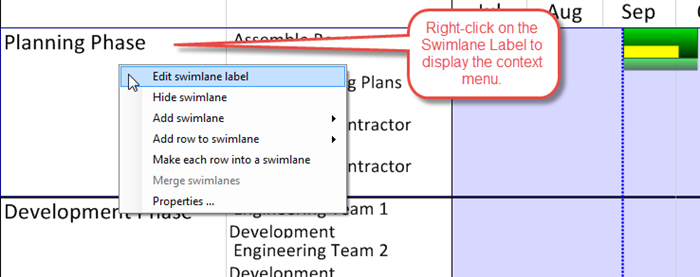
- c) Descriptions of the controls within the above context menu can be found at the links referenced at the end of this article.
2) Right-clicking on any additional text column cell:
- a) Right-click to select a row (or group of rows).
- b) The context menu shown below will be displayed:
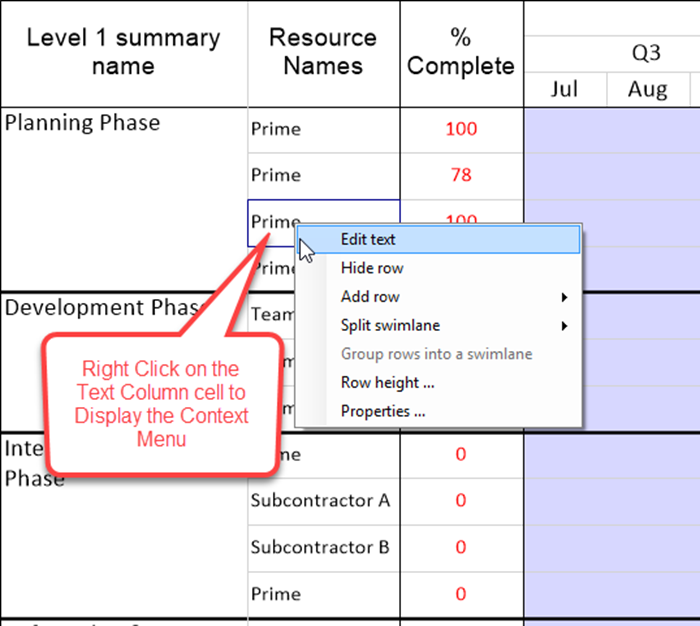
- c) Descriptions of the controls within the above context menu can be found at the links referenced at the end of this article.
Links to Detailed Articles on Creating and Editing Rows and Swimlanes
More detailed information on editing rows and swimlanes can be accessed at the following article links:
(12.0.1-60)